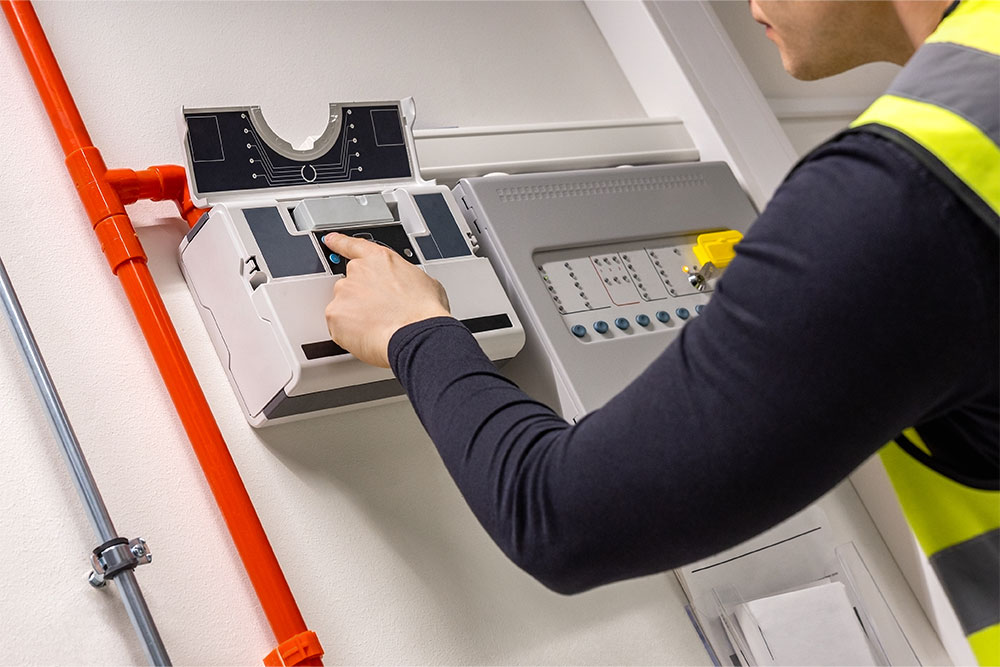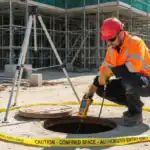
Keeping your business safe is crucial, and having the right fire alarm system is a big part of that. However, there are many types of fire alarm systems, and choosing the right one can be confusing.
This guide will help you understand the different types and how to pick the best one for your business. By choosing the right system, you can protect your employees, customers and property from the dangers of fire.
Fire Safety Regulations
Before deciding what type of fire alarm system you need, you should determine if you need one at all. In the UK, this is controlled by the Regulatory Reform (Fire Safety) Order 2005 (FSO), which applies to all workplaces.
Most workplaces need a fire alarm system. Only workplaces small enough for a fire to be immediately noticeable are exempt.
However, this decision can only be settled through a proper fire risk assessment. Your assessment will help you identify any specific risks and the necessary level of fire protection to keep everyone safe. This includes whether you need a fire alarm system and how complex it needs to be.
Types of Fire Alarms
There are several types of fire alarm systems, each designed to meet different needs and environments. Understanding these types will help you decide which is best for your business.
Fire Safety Training
Our Fire Safety Training course gives a basic understanding of fire prevention principles, the sources of ignition and fuel and safe systems of work to prevent fire hazards and accidents within the work environment.
Conventional Fire Alarm Systems
Conventional fire alarm systems divide your premises into zones. When an alarm is triggered, the system identifies the zone where the alarm originated. This helps locate the fire quickly but doesn’t pinpoint the exact location.
Conventional systems are typically more cost-effective and are suitable for smaller businesses with simpler layouts.
Addressable Fire Alarm Systems
Addressable fire alarm systems are more advanced. Each device on the system, such as fire detectors and call points, has its own address. When an alarm is triggered, the system identifies the device’s exact location.
This precision makes addressable systems ideal for larger buildings with more complex layouts. It also makes them more expensive than conventional systems.
Wireless Fire Alarm Systems
Wireless fire alarm systems use radio signals to communicate between devices and the control panel. This type of system is easier and faster to install because it eliminates the need for extensive wiring.
Wireless systems are especially useful in historic buildings or sites where installing cables would be difficult. However, they can be more costly, and each device’s battery must be regularly checked.
Hybrid Fire Alarm Systems
Hybrid fire alarm systems combine elements of wired and wireless systems. This flexibility allows you to have a customised solution that meets your building’s specific needs. For example, you might use wired detectors in new sections of a building and wireless detectors in older, more challenging areas.
Types and Categories of Fire Alarms
When selecting a fire alarm system, it’s important to understand the difference between types and categories.
The “types” of fire alarm systems refer to the technical setup.
The “categories” of fire alarm systems outline the level of protection they offer and are crucial for compliance with fire safety regulations. Categories of fire alarm systems are defined in British Standard 5839.
BS 5839 provides guidelines for the design, installation and maintenance of fire alarm systems. Complying with this standard is a good way to ensure your system meets fire safety regulations.
Fire Alarm British Standards
British Standard 5389 defines different grades of fire alarm systems, ranging from A to F, with A being the most sophisticated and F the simplest.
Grades A to C are suitable for businesses, with D and below reserved for domestic premises.
There are two main types of fire alarm systems within BS 5839: Life Protection (L) systems and Property Protection (P) systems. Each system is then numbered to indicate the level of coverage and protection, with 1 being the highest and 5 the lowest.
For Life Protection systems:
- L1: Provides automatic fire detection throughout the building.
- L2: Includes automatic fire detection in high-risk areas and escape routes.
- L3: Detects fire in escape routes and rooms opening onto escape routes.
- L4: Focuses on detection in escape routes only.
- L5: Tailored systems designed to address specific fire risks in particular areas.
For Property Protection systems:
- P1: Provides automatic fire detection throughout the building to protect property.
- P2: Focuses on detection in specified areas where the risk of fire is higher or where critical assets are located.
Advice for Choosing a Fire Alarm for Your Business
Choosing the right fire alarm system for your business can seem daunting, but following a few clear steps can help simplify the process. Here’s how to ensure you select the best system for your needs:
Conduct a Fire Risk Assessment
Start by carrying out a thorough fire risk assessment as required by the Fire Safety Order. This will help you identify the specific fire risks in your workplace and determine the level of protection needed.
Consider Your Business Size and Layout
The size and layout of your premises are some of the most important deciding factors.
Smaller businesses with simpler layouts may find conventional systems sufficient. In contrast, larger premises with more complex layouts might benefit from addressable or wireless systems for their more precise monitoring and control.
Identify High-Risk Areas
Look at the specific areas within your business that pose higher fire risks, such as kitchens, server rooms or areas with flammable materials. Categories like L2 or L5 systems provide targeted protection for these high-risk zones.
Budget Considerations
While it’s essential to ensure robust fire safety, it’s also important to consider your budget. Conventional systems might be more cost-effective for small businesses, whereas addressable or hybrid systems, although more expensive, offer advanced features suitable for larger businesses.
Professional Installation and Maintenance
It’s best to trust a professional to install and set up your fire alarm system. Regular maintenance and testing, as recommended by BS 5839, are crucial to keeping your system functional and compliant.

Training Your Staff
Ensure that all employees are trained on how to respond when the fire alarm sounds. Regular fire drills can help staff become familiar with evacuation procedures, further enhancing safety.
Key Takeaways
- Ensure your business complies with the Regulatory Reform (Fire Safety) Order 2005 by conducting a thorough fire risk assessment to determine which fire alarm system is needed.
- Consider the different types, grades and categories of fire alarm systems and choose the one that best suits your business’s size, layout and specific needs.
- Follow BS 5839 guidelines for fire alarm systems to ensure compliance with UK fire safety regulations. Grades A to C are suitable for business premises.
- Train employees on what to do in the event of a fire and conduct fire drills to familiarise them with evacuation procedures.
Fire Safety Training
Choosing the right fire alarm system is crucial in protecting your business. However, fire safety doesn’t stop there. Equipping your staff with the knowledge and skills to prevent and respond to fires effectively is equally important. This is where Fire Safety Training becomes essential.
Our online Fire Safety Training courses provide users with a comprehensive understanding of occupational fire risks and the safety measures necessary to control them. These courses suit employees at all experience levels and are designed to promote fire safety and support employers in meeting their legal duties.
Approved by the International Institute of Risk and Safety Management (IIRSM), our fire safety courses ensure your staff are well-prepared to handle fire emergencies. Your team will be better equipped to identify fire hazards, understand fire prevention strategies and act appropriately when your fire alarm system (whichever you choose) activates.





















